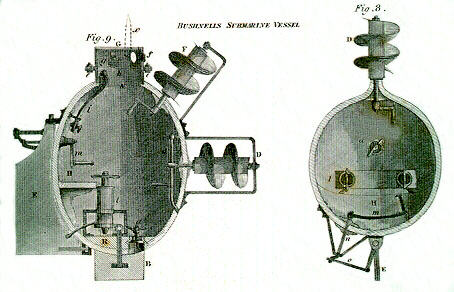Fulton's Submarine
Today, Robert Fulton tries to build a submarine. The University of Houston's College of Engineering presents this series about the machines that make our civilization run, and the people whose ingenuity created them.
David Bushnell, a student at Yale, built a small hand-cranked submarine called the Turtle early in the American Revolution. He tried to blow up the English navy with it, but he failed. Yet he planted the idea of workable submarines in a lot of minds.
Bushnell got his idea from the English Gentleman's Magazine in the Yale library. One issue sketched a submarine very much like his Turtle. He wrote a master's thesis on the Turtle, but he didn't publish it until 1799. Long before that, one of Bushnell's classmates had become a close friend of Robert Fulton.
So in 1797 -- long before he built his famous steamboat -- Fulton was to be found in France raising money for his own submarine. The French wanted no part of such dirty warfare. Sneaking about underwater was not how gentlemen waged war.
When Napoleon came to power, Fulton tried another tack. He argued that a French submarine would create universal peace by ending naval warfare forever. Napoleon shrewdly let Fulton use his own money to start the work, and then he sanctioned the effort.
In his search for French funding, Fulton claimed his machine was original. He also cursed the terrible English who had to be destroyed. At the same time, he sent a friend to London to see if the English would be more receptive. To French objections about undersea warfare, he said, "It is certainly the gentlest and least bloody method the philosopher can imagine to overturn war."
Fulton finished his first sub in 1800 and tried to sink English blockade ships with it. It was a scaled-up version of Bushnell's Turtle, with most of the same features. Like Bushnell, he had trouble locating an enemy ship once he was underwater. His plan of dragging a floating mine into a vessel as he passed under it proved to be impractical.
Finally the hope of support looked better in England. So Fulton went to London, where he tangled in years of negotiations with the Admiralty. How much would he charge, for example, to keep his sub out of American hands? By now, Bushnell's account of the Turtle was in print, so Fulton could no longer claim to be original.
Effective submarines had to wait for the invention of battery-powered motors. But while Fulton was in England, a workable steamboat was built in Scotland, and steamboats had also been on Fulton's mind. He finally went back to America without having ended naval warfare. He turned his inventive energies on the steamboat.
Passenger steamboats, like military submarines, were, of course, spun from the dreams of many people. Fulton may have been willing to say whatever he thought potential patrons wanted to hear. But in the end, he too was dream-driven. And he finally did make a boat so successful that it changed history.
I'm John Lienhard, at the University of Houston, where we're interested in the way inventive minds work.
(Theme music)
Flexner, J.T., Steamboats Come True. Boston: Little, Brown and Company, 1978.
To learn what became of David Bushnell after he built his Turtle, see Episode 638.

(From the 1832 Edinburgh Encyclopaedia)
Artist's conception of Bushnell's Turtle, 56 year after the fact